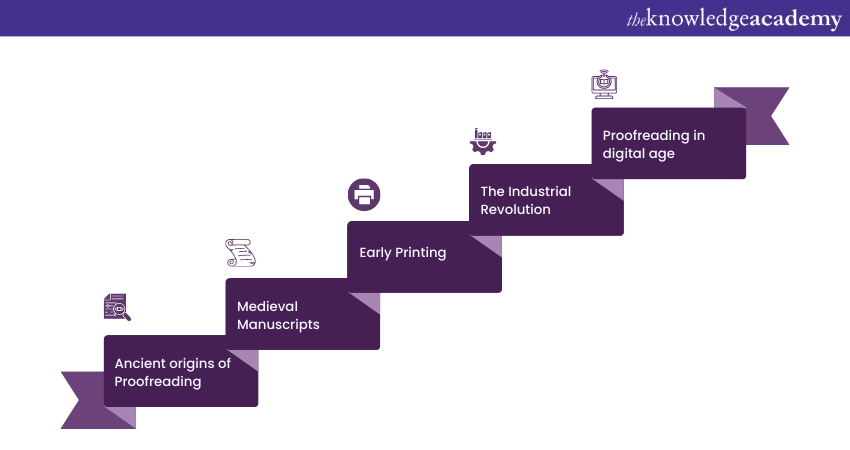We may not have the course you’re looking for. If you enquire or give us a call on +27 800 780004 and speak to our training experts, we may still be able to help with your training requirements.
Training Outcomes Within Your Budget!
We ensure quality, budget-alignment, and timely delivery by our expert instructors.

Behind every well-crafted piece of literature, every meticulously edited Manuscript, and every error-free publication stands the unsung hero known as Proofreading. But did you know where this technique took birth? The History of Proofreading is a fascinating journey that has spanned centuries, witnessing the development of techniques. It went beyond the rise of dedicated professionals and the ever-evolving challenges posed by changing technologies.
So, why just stop at mastering this technique and skill development? Why not explore its history in detail? Read this blog to learn about the History of Proofreading. Also, learn about the evolution of this essential art of accuracy, and discover its significance.
Table of Contents
1) A brief History of Proofreading
a) Ancient Origins of Proofreading
b) Medieval Manuscripts and early printing
c) The Industrial Revolution and beyond
d) Proofreading in the digital age
2) Conclusion
A brief History of Proofreading
Proofreading is the art of meticulously reviewing written content to identify and correct errors. It has a rich and intriguing history that dates back to the earliest forms of written communication.
From ancient civilisations to the digital age, the evolution of this technique has played a vital role in ensuring accuracy and clarity in written texts. So, let’s embark on into the captivating realm of the History of Proofreading and uncover the remarkable story it has to tell:

Ancient origins of Proofreading
The History of Proofreading stretches back to the ancient origins of written communication. In ancient civilisations such as Mesopotamia, Egypt, and Greece, Scribes played a crucial role in transcribing texts and implementing early Proofreading techniques. These early Proofreaders recognised the importance of accuracy and carefully compared and corrected their work.
Ready to enhance your Proofreading skills? Register for our Proofreading Masterclass now!
Medieval Manuscripts and early printing
The Middle Ages brought about significant advancements in the production of written material. Monastic scriptoria, found within monasteries, became centres of transcription and learning. Monks meticulously copied texts by hand and engaged in extensive Proofreading to eliminate errors. The scarcity of written materials during this time heightened the importance of Proofreading as monks sought to preserve the integrity and reliability of the Manuscripts.
With the advent of the printing press in the 15th century, the landscape of Proofreading underwent a transformative shift. Printers and publishers recognised the need for accurate texts and relied on skilled Proofreaders to meticulously review typeset pages before printing. Proofreaders collaborated with printers and employed standardised Proofreading marks to communicate corrections effectively.
To leverage your review process, refer our blog on "Proofreading tips"
The Industrial Revolution and beyond
One of the greatest turns that took place in the History of Proofreading was the Industrial Revolution. It is because the Industrial Revolution in the 18th and 19th centuries brought about significant advancements in printing technology.
As the demand for printed materials grew, Proofreading played an increasingly important role in ensuring accuracy. Professional Proofreaders emerged, deeply understanding grammar, spelling, and punctuation. They meticulously reviewed Manuscripts, making corrections and ensuring consistency in adherence to established standards.
Embark on a journey of personal development with our Personal Development Training.
Proofreading in the digital age
The advent of the digital age revolutionised the publishing industry and presented new challenges and opportunities for Proofreading. With the proliferation of online content, Proofreaders adapted their skills to digital formats.
They began using advanced editing software and collaborated remotely with authors and editors. The digital era also brought about automated Proofreading tools that can help detect spelling and grammar errors, providing valuable support to human Proofreaders.
To get a deeper understanding of Proof reading and its types, refer our blog ob "Types of Proofreading"
In today’s digital landscape, Proofreading remains an indispensable part of the publishing process. Despite technological advancements, human Proofreaders continue to play a vital role in ensuring accuracy, clarity, and consistency in written content. Their expertise and attention to detail are essential in catching errors that automated tools may overlook.
The History of Proofreading showcases its enduring significance in the world of written communication. From the ancient origins of Proofreading in ancient civilisations to the advancements in the digital age, Proofreaders continue to uphold the integrity and quality of written content. They combine their expertise with cutting-edge tools. As the written word continues to evolve, the technique remains an invaluable process in ensuring accuracy and effective communication.

Conclusion
the History of Proofreading paints a vivid picture of its remarkable evolution throughout the ages. As the it continues to unfold, its legacy stands as a testament to the power of precision, attention to detail, and the enduring value of accurate written communication.
Don't miss out on the opportunity to captivate readers with your words. Register for our Creative Writing Training now!
Frequently Asked Questions
Upcoming Business Skills Resources Batches & Dates
Date
 Proofreading Course
Proofreading Course
Fri 14th Feb 2025
Fri 11th Apr 2025
Fri 13th Jun 2025
Fri 15th Aug 2025
Fri 10th Oct 2025
Fri 12th Dec 2025







 Top Rated Course
Top Rated Course


 If you wish to make any changes to your course, please
If you wish to make any changes to your course, please


